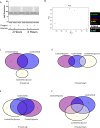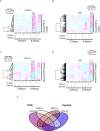STAT3 precedes HIF1α transcriptional responses to oxygen and oxygen and glucose deprivation in human brain pericytes
- PMID: 29518129
- PMCID: PMC5843348
- DOI: 10.1371/journal.pone.0194146
STAT3 precedes HIF1α transcriptional responses to oxygen and oxygen and glucose deprivation in human brain pericytes
Abstract
Brain pericytes are important to maintain vascular integrity of the neurovascular unit under both physiological and ischemic conditions. Ischemic stroke is known to induce an inflammatory and hypoxic response due to the lack of oxygen and glucose in the brain tissue. How this early response to ischemia is molecularly regulated in pericytes is largely unknown and may be of importance for future therapeutic targets. Here we evaluate the transcriptional responses in in vitro cultured human brain pericytes after oxygen and/or glucose deprivation. Hypoxia has been widely known to stabilise the transcription factor hypoxia inducible factor 1-alpha (HIF1α) and mediate the induction of hypoxic transcriptional programs after ischemia. However, we find that the transcription factors Jun Proto-Oncogene (c-JUN), Nuclear Factor Of Kappa Light Polypeptide Gene Enhancer In B-Cells (NFκB) and signal transducer and activator of transcription 3 (STAT3) bind genes regulated after 2hours (hs) of omitted glucose and oxygen before HIF1α. Potent HIF1α responses require 6hs of hypoxia to substantiate transcriptional regulation comparable to either c-JUN or STAT3. Phosphorylated STAT3 protein is at its highest after 5 min of oxygen and glucose (OGD) deprivation, whereas maximum HIF1α stabilisation requires 120 min. We show that STAT3 regulates angiogenic and metabolic pathways before HIF1α, suggesting that HIF1α is not the initiating trans-acting factor in the response of pericytes to ischemia.
Conflict of interest statement
Figures






Similar articles
-
Inhibition of VEGF expression through blockade of Hif1α and STAT3 signalling mediates the anti-angiogenic effect of melatonin in HepG2 liver cancer cells.Br J Cancer. 2013 Jul 9;109(1):83-91. doi: 10.1038/bjc.2013.285. Epub 2013 Jun 11. Br J Cancer. 2013. PMID: 23756865 Free PMC article.
-
STAT3 and HIF1α cooperatively activate HIF1 target genes in MDA-MB-231 and RCC4 cells.Oncogene. 2014 Mar 27;33(13):1670-9. doi: 10.1038/onc.2013.115. Epub 2013 Apr 22. Oncogene. 2014. PMID: 23604114 Free PMC article.
-
HIF-1α activation under glucose deprivation plays a central role in the acquisition of anti-apoptosis in human colon cancer cells.Int J Oncol. 2014 Jun;44(6):2077-84. doi: 10.3892/ijo.2014.2367. Epub 2014 Apr 3. Int J Oncol. 2014. PMID: 24718784
-
Molecular Regulation of the Response of Brain Pericytes to Hypoxia.Int J Mol Sci. 2023 Mar 16;24(6):5671. doi: 10.3390/ijms24065671. Int J Mol Sci. 2023. PMID: 36982744 Free PMC article. Review.
-
Crosstalk between Mdm2, p53 and HIF1-α: distinct responses to oxygen stress and implications for tumour hypoxia.Subcell Biochem. 2014;85:199-214. doi: 10.1007/978-94-017-9211-0_11. Subcell Biochem. 2014. PMID: 25201196 Review.
Cited by
-
Incretin Mimetics Restore the ER-Mitochondrial Axis and Switch Cell Fate Towards Survival in LUHMES Dopaminergic-Like Neurons: Implications for Novel Therapeutic Strategies in Parkinson's Disease.J Parkinsons Dis. 2023;13(7):1149-1174. doi: 10.3233/JPD-230030. J Parkinsons Dis. 2023. PMID: 37718851 Free PMC article.
-
Energy Metabolism in Cancer: The Roles of STAT3 and STAT5 in the Regulation of Metabolism-Related Genes.Cancers (Basel). 2020 Jan 3;12(1):124. doi: 10.3390/cancers12010124. Cancers (Basel). 2020. PMID: 31947710 Free PMC article. Review.
-
REST Targets JAK-STAT and HIF-1 Signaling Pathways in Human Down Syndrome Brain and Neural Cells.Int J Mol Sci. 2023 Jun 10;24(12):9980. doi: 10.3390/ijms24129980. Int J Mol Sci. 2023. PMID: 37373133 Free PMC article.
-
Remote ischemic conditioning enhances oxygen supply to ischemic brain tissue in a mouse model of stroke: Role of elevated 2,3-biphosphoglycerate in erythrocytes.J Cereb Blood Flow Metab. 2021 Jun;41(6):1277-1290. doi: 10.1177/0271678X20952264. Epub 2020 Sep 15. J Cereb Blood Flow Metab. 2021. PMID: 32933360 Free PMC article.
-
Targeting pericytes for neurovascular regeneration.Cell Commun Signal. 2019 Mar 20;17(1):26. doi: 10.1186/s12964-019-0340-8. Cell Commun Signal. 2019. PMID: 30894190 Free PMC article. Review.
References
-
- Hawkins BT, Davis TP (2005) The blood-brain barrier/neurovascular unit in health and disease. Pharmacol Rev 57: 173–185. doi: 10.1124/pr.57.2.4 - DOI - PubMed
-
- Sweeney MD, Ayyadurai S, Zlokovic BV (2016) Pericytes of the neurovascular unit: key functions and signaling pathways. Nat Neurosci 19: 771–783. doi: 10.1038/nn.4288 - DOI - PMC - PubMed
-
- Bell RD, Winkler EA, Sagare AP, Singh I, LaRue B, Deane R, et al. (2010) Pericytes control key neurovascular functions and neuronal phenotype in the adult brain and during brain aging. Neuron 68: 409–427. doi: 10.1016/j.neuron.2010.09.043 - DOI - PMC - PubMed
-
- Winkler EA, Bell RD, Zlokovic BV (2011) Lack of Smad or Notch leads to a fatal game of brain pericyte hopscotch. Dev Cell 20: 279–280. doi: 10.1016/j.devcel.2011.03.002 - DOI - PubMed
-
- Beckman JD, Grazul-Bilska AT, Johnson ML, Reynolds LP, Redmer DA (2006) Isolation and characterization of ovine luteal pericytes and effects of nitric oxide on pericyte expression of angiogenic factors. Endocrine 29: 467–476. - PubMed
Publication types
MeSH terms
Substances
LinkOut - more resources
Full Text Sources
Other Literature Sources
Molecular Biology Databases
Miscellaneous

